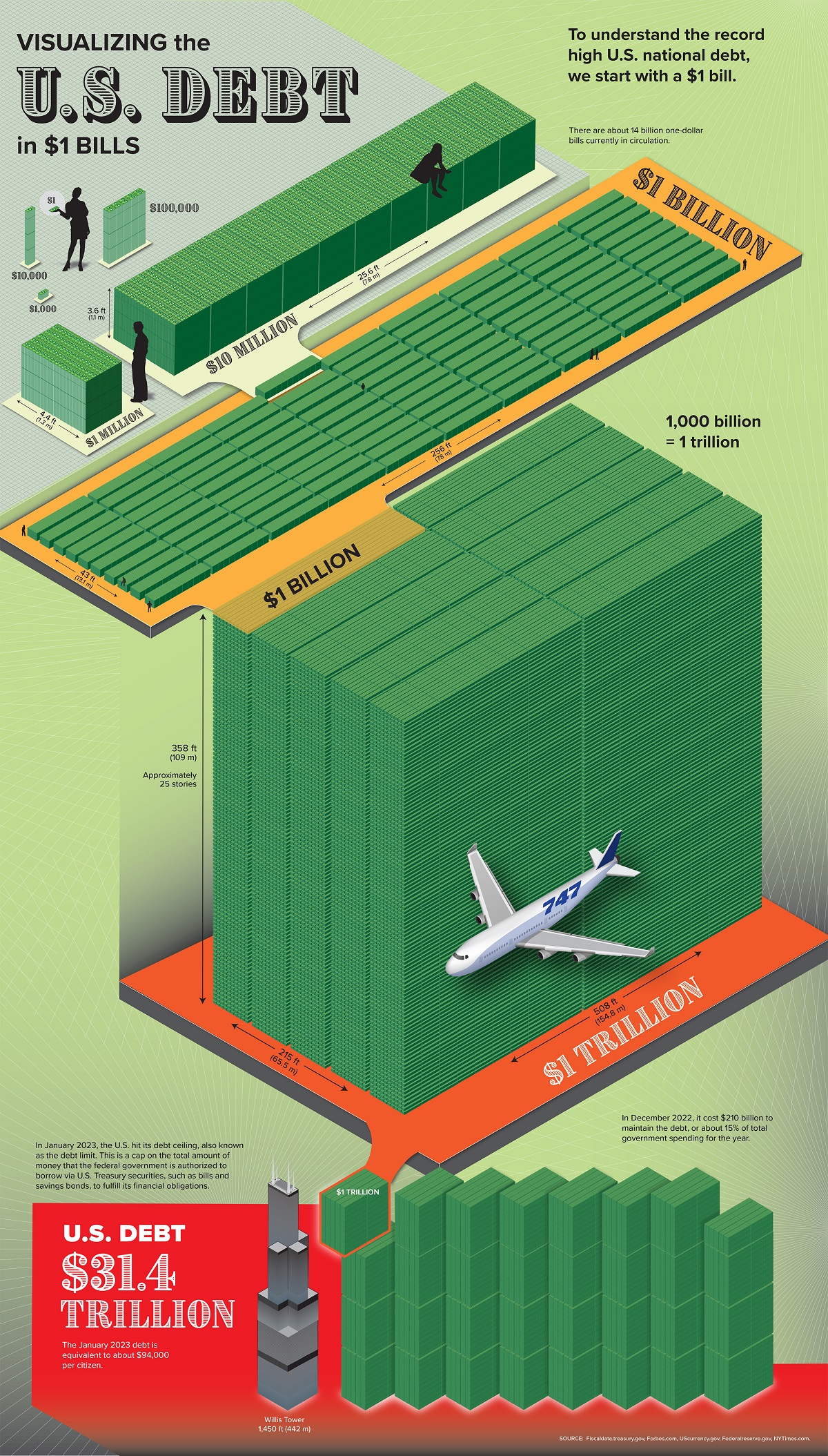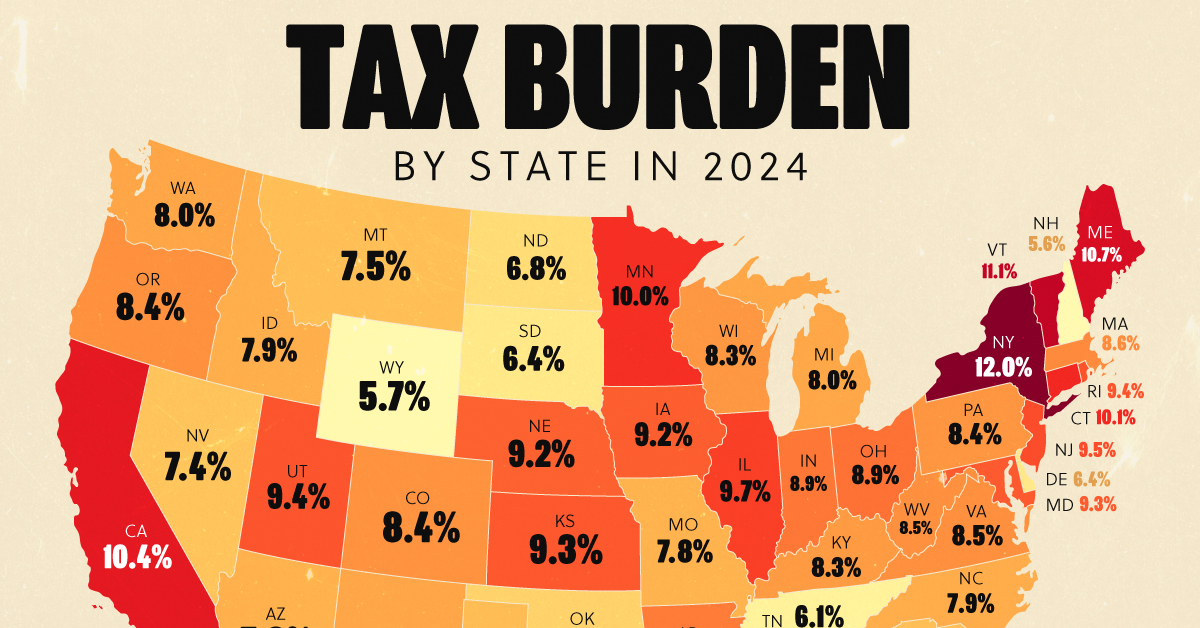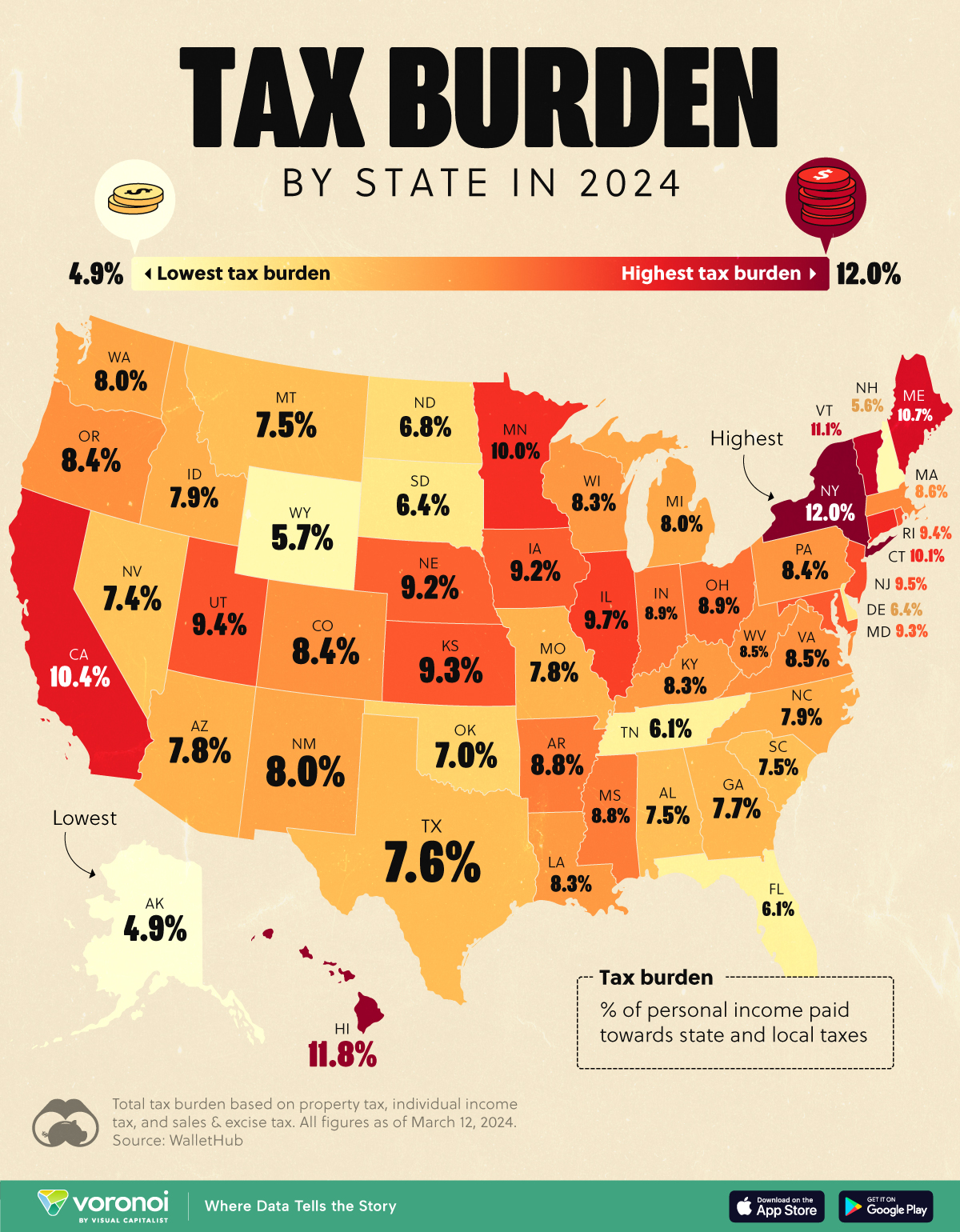Money
U.S. Debt: Visualizing the $31.4 Trillion Owed in 2023

U.S. Debt: Visualizing the $31.4 Trillion Owed in 2023
Can you picture what $31.4 trillion looks like?
The enormity of U.S. government debt is hard for the average person to wrap their head around. For instance, compared to the median U.S. mortgage, the current level of federal debt is 230 million times larger.
In this graphic, Julie Peasley shows how many one-dollar bills it would take to stack up to the total U.S. debt of $31.4 trillion.
How Did U.S. Debt Get So High?
U.S. national debt is how much money the federal government owes to creditors. When the government spends more than it earns, it has a budget deficit and must issue debt in the form of Treasury securities.
The U.S. has run a deficit for the last 20 years, substantially increasing the national debt. In fact, according to the Department of the Treasury, the current debt is $31.4 trillion.
Stacked up in one-dollar bills, the U.S. debt would be equivalent to almost eight of Chicago’s 110-story Willis Tower.
| Year | Outstanding Debt | Year-Over-Year Increase |
|---|---|---|
| 2023* | $31.4T | 2% |
| 2022 | $30.9T | 9% |
| 2021 | $28.4T | 6% |
| 2020 | $26.9T | 19% |
| 2019 | $22.7T | 6% |
| 2018 | $21.5T | 6% |
| 2017 | $20.2T | 3% |
| 2016 | $19.6T | 8% |
| 2015 | $18.2T | 2% |
| 2014 | $17.8T | 6% |
| 2013 | $16.7T | 4% |
| 2012 | $16.1T | 9% |
| 2011 | $14.8T | 9% |
| 2010 | $13.6T | 14% |
| 2009 | $11.9T | 19% |
| 2008 | $10.0T | 11% |
| 2007 | $9.0T | 6% |
| 2006 | $8.5T | 7% |
| 2005 | $7.9T | 8% |
| 2004 | $7.4T | 9% |
| 2003 | $6.8T | 9% |
| 2002 | $6.2T | 7% |
| 2001 | $5.8T | 2% |
| 2000 | $5.7T | 0% |
Source: Fiscal Data. Debt for 2023 is as of January, with the year-over-year increase reflecting the growth from October 2022 to January 2023. October is the start of the fiscal year for the U.S. government. Debt includes both debt held by the public and intragovernmental holdings.
The last time the government had a surplus was in 2001, when debt rose only 2% due to interest costs. Since then, the largest jumps in U.S. debt have been during the Global Financial Crisis—which saw three straight years of double-digit growth rates—and in 2020 due to trillions of dollars of COVID-19 stimulus.
U.S. federal debt rises during recessions because government revenue, primarily composed of taxes, decreases. At the same time, the government increases spending to help stimulate an economic recovery.
And in today’s case, the U.S. is facing additional financial issues. As the country’s senior population grows and people live longer, this puts pressure on programs that serve older Americans such as Social Security. Healthcare is becoming more expensive and is the second-fastest growing part of the U.S. budget.
The Pros and Cons of Debt
U.S. debt helps fund critical programs for Americans, including retirement and disability benefits, healthcare, economic security, and national defense.
As one example of the impact of these programs, income security nearly halved the percent of the population living below the poverty line in 2019 from 22.8% to 12.2%.
Of course, U.S. debt also comes with challenges. A chief concern is the ability to pay the interest costs on U.S. debt, especially as interest rates rise.
Before rate hikes began, interest costs amounted to 6% of the U.S. budget in the 2021 fiscal year. Fast forward to December 2022, and interest costs amounted to 15% of total government spending since the start of the fiscal year in October.
Addressing the Problem
In January 2023, the U.S. hit its debt ceiling, also known as its borrowing limit. While some countries tie their debt to GDP, the U.S. sets an exact limit in dollar terms.
The government would run out of money to pay its debts this summer if the ceiling is not raised, though policymakers have historically agreed to debt ceiling increases in the past to avoid a default. In 2011, the U.S. narrowly avoided default due to a last-minute debt ceiling negotiation and the country’s credit rating was downgraded as a result.
Tackling U.S. debt is simple in theory: raise taxes or the debt limit, reduce spending, or a combination of all three. However, it’s much more difficult in practice. Which taxes should be raised? Which programs should be cut? What happens the next time the debt limit is reached?

This article was published as a part of Visual Capitalist's Creator Program, which features data-driven visuals from some of our favorite Creators around the world.
Wealth
Visualizing the Tax Burden of Every U.S. State
Tax burden measures the percent of an individual’s income that is paid towards taxes. See where it’s the highest by state in this graphic.

Visualizing the Tax Burden of Every U.S. State
This was originally posted on our Voronoi app. Download the app for free on iOS or Android and discover incredible data-driven charts from a variety of trusted sources.
This map graphic visualizes the total tax burden in each U.S. state as of March 2024, based on figures compiled by WalletHub.
It’s important to understand that under this methodology, the tax burden measures the percent of an average person’s income that is paid towards state and local taxes. It considers property taxes, income taxes, and sales & excise tax.
Data and Methodology
The figures we used to create this graphic are listed in the table below.
| State | Total Tax Burden |
|---|---|
| New York | 12.0% |
| Hawaii | 11.8% |
| Vermont | 11.1% |
| Maine | 10.7% |
| California | 10.4% |
| Connecticut | 10.1% |
| Minnesota | 10.0% |
| Illinois | 9.7% |
| New Jersey | 9.5% |
| Rhode Island | 9.4% |
| Utah | 9.4% |
| Kansas | 9.3% |
| Maryland | 9.3% |
| Iowa | 9.2% |
| Nebraska | 9.2% |
| Ohio | 8.9% |
| Indiana | 8.9% |
| Arkansas | 8.8% |
| Mississippi | 8.8% |
| Massachusetts | 8.6% |
| Virginia | 8.5% |
| West Virginia | 8.5% |
| Oregon | 8.4% |
| Colorado | 8.4% |
| Pennsylvania | 8.4% |
| Wisconsin | 8.3% |
| Louisiana | 8.3% |
| Kentucky | 8.3% |
| Washington | 8.0% |
| New Mexico | 8.0% |
| Michigan | 8.0% |
| North Carolina | 7.9% |
| Idaho | 7.9% |
| Arizona | 7.8% |
| Missouri | 7.8% |
| Georgia | 7.7% |
| Texas | 7.6% |
| Alabama | 7.5% |
| Montana | 7.5% |
| South Carolina | 7.5% |
| Nevada | 7.4% |
| Oklahoma | 7.0% |
| North Dakota | 6.8% |
| South Dakota | 6.4% |
| Delaware | 6.4% |
| Tennessee | 6.1% |
| Florida | 6.1% |
| Wyoming | 5.7% |
| New Hampshire | 5.6% |
| Alaska | 4.9% |
From this data we can see that New York has the highest total tax burden. Residents in this state will pay, on average, 12% of their income to state and local governments.
Breaking this down into its three components, the average New Yorker pays 4.6% of their income on income taxes, 4.4% on property taxes, and 3% in sales & excise taxes.
At the other end of the spectrum, Alaska has the lowest tax burden of any state, equaling 4.9% of income. This is partly due to the fact that Alaskans do not pay state income tax.
Hate Paying Taxes?
In addition to Alaska, there are several other U.S. states that don’t charge income taxes. These are: Florida, Nevada, South Dakota, Tennessee, Texas, Washington, and Wyoming.
It’s also worth noting that New Hampshire does not have a regular income tax, but does charge a flat 4% on interest and dividend income according to the Tax Foundation.
Learn More About Taxation From Visual Capitalist
If you enjoyed this post, be sure to check out this graphic which ranks the countries with the lowest corporate tax rates, from 1980 to today.
-

 Markets5 days ago
Markets5 days agoMapped: The Most Valuable Company in Each Southeast Asian Country
-

 Markets2 weeks ago
Markets2 weeks agoThe Top Private Equity Firms by Country
-

 Jobs2 weeks ago
Jobs2 weeks agoThe Best U.S. Companies to Work for According to LinkedIn
-

 Economy2 weeks ago
Economy2 weeks agoRanked: The Top 20 Countries in Debt to China
-

 Politics1 week ago
Politics1 week agoCharted: Trust in Government Institutions by G7 Countries
-

 Energy1 week ago
Energy1 week agoMapped: The Age of Energy Projects in Interconnection Queues, by State
-

 Mining1 week ago
Mining1 week agoVisualizing Global Gold Production in 2023
-

 Markets1 week ago
Markets1 week agoVisualized: Interest Rate Forecasts for Advanced Economies








